My 2017 Eclipse Experience at Agate Fossil Beds National Monument
Lucky me, I live in the path of totality!
Eclipse fever descended upon the Wyobraska region in the past month. It was a welcome distraction from politics to spectate all the worrying about how many people might come and whether we were properly prepared. (Gas up your cars! Stock up on food and water and toilet paper! Order extra medical supplies! Be nice to the tourists!)
I rather wonder if all the fuss about traffic scared some people off. I got a text message from a friend in Colorado on Friday asking if the traffic in Scottsbluff was bad because of the eclipse on Monday. (It wasn’t in the least.)
I wish I’d done a blog post about all the places to view the eclipse in this area. I think it might’ve helped people find us among the sea of options. Sounds like a big chunk of Colorado went to Wyoming. We here are a pretty (Nebraska) nice place to visit, and the people who did were pleased. (I find it interesting that people were surprised that they were not charged for parking, another example here.)
But I was having a hard enough time deciding where to go myself.
At first, I’d thought about viewing the eclipse from the roof of the Midwest Theater where I work. It’d have a good view of the skyline all the way around, and I wouldn’t have to risk driving anywhere. But, there were photosensor streetlights around. And the roof would probably be hot.
Then a shindig was planned for the University of Nebraska Panhandle Research and Extension Center where Bugman works. Sounds nice, but what would the traffic be like? Was it worth the travel across town?
Another interesting option – viewing the eclipse at Riverside Discovery Center (our local zoo), to see if the eclipse would have any impact on animal behavior. (It didn’t, really.) I found out too late that Legacy of the Plains Museum was looking for parking help for the day, too.
The deciding factor: I saw a newspaper blurb that Agate Fossil Beds National Monument was seeking volunteer help for parking and visitor greeting activities the day of the eclipse. They probably would need the help! Crowds could exceed normal visitation rates by orders of magnitude at the small rural park. Also, Agate had a bit more totality than Scottsbluff (about 2:20 compared to about 1:45).
But, there is no camping at Agate, and I wouldn’t want to get up early to potentially wade through a lot of traffic of Monday. BUT . . . we have a friend who’s a ranger at the park and lives onsite. He said we were welcome to set up a tent in his yard Sunday night! Score!!

How could you not want to spend time in the company of these adorkable people?? #rangerspointingatthings (photo credit Agate Fossil Beds National Monument)
Also, Bugman applied for a research permit so he could go into a restricted area and set up recording equipment to see if the darkness of the eclipse would have any effect on insect behavior. The Niobrara River runs through the park, and lots of moisture means lots of insects!
As the day approached, I congratulated myself on my decision, as the cloud forecast for Scottsbluff looked a little iffy. Things looked better around the Agate area.
I began planning for the event. Agate Fossil Bed National Monument is rural, so it’s best to be as self-sufficient as possible.

We packed camping supplies (food, headlamps, first aid kit, tent, sleeping bags, chairs, bottles of coffee), along with a garden bounty of tomatoes and cucumbers to share with the other folks we’d be yard-camping with.
We headed north on Sunday afternoon with a full tank of gas, early enough to get set up before a 5 p.m. volunteer orientation meeting. Already, there were rogue tents and campers dotting the edges of Highway 29.

Sunday afternoon, campers were parked next to the road maintenance gravel pile on Highway 29, and cars were parked / tents pitched behind it.
This park-by-the-roadside strategy for eclipse viewing had emergency managers on edge. Hot vehicle parts have been known to start devastating grass fires in this part of the state. Luckily for all of us, there had been some decent rains in the previous week, so things weren’t quite as tinder-dry out there as they could have been.
Still, Agate’s website warned of the danger.

Another alert on the Agate website:

We put our cell phones in airplane mode. We would have zero cell service for the duration of the eclipse. It felt a bit unnerving, but it was wonderful, too. A break from political news!!!
As we pulled into Agate, it became clear it would be a popular place for eclipse viewing. Preparations had been made. A portion of the Daemonelix Trail parking area was roped off for incident command. Several sections of the park along the road had been mowed and barricaded, and portable toilets were stationed near the barricades. We passed the visitor center to get to the ranger residence area where we’d be staying. The visitor center was swarming with people, and a mowed section of grass had already been deployed as overflow parking.
We pulled up to our friend’s house. A rental RV dominated the driveway, and a large tent bloomed next to it in the yard. Tables and lawn chairs claimed the portion of the driveway nearest the open garage door. Bugman and I set up our little tent near the gigantic one.
I felt privileged to be able to put down stakes in the private section of the park.

With camp set up, we headed over to the visitor center for the 5pm volunteer training, which turned out to be a meeting primarily for volunteer astronomers who would be hosting a star party that night. Our training was at 5AM! Oh well. Got my volunteer packet, anyhow!

Got our eclipse glasses! Sweet!
I didn’t include it in the picture, but I also got a volunteer badge on a cord. I was oh-so-grateful when a fellow yard camper caught my Wayne’s World reference when I called it my “backstage pass.”
We headed back to “camp,” where another couple of tents had been set up in the yard. I attempted to fly a kite while Bugman took the opportunity to set up and tweak his equipment in our friend’s backyard.

Ah, the golden evening light on the high plains!

Yes, Vickimom – that is one of the socks you gave him for his birthday being repurposed as a wind screen for a microphone. 😀
With the wind dying down and the equipment check complete, we headed back to the driveway to be social and share a meal with the motley crew assembled for the occasion.

The party space: RV, giant tent (ours is hiding behind), tables, garage.
One of our fellow eclipse visitor had brought wine glasses and paint pens, so everyone could make their own souvenir. Great idea!

Bugman works on his wine glass.

I based my eclipse glass design on a vague recollection of a myth about the sun and moon being doomed lovers who seldom meet, and also on the fact that Bugman and I would celebrate our 19th wedding anniversary the day after the eclipse.

So much wonderful food! Grilled meat and vegetables, pasta salads, garden veggies, pies and ice cream! And good company!
That night as the sun set, the stars began to come out in a way they do not in Scottsbluff. The lack of light pollution around Agate meant a wonderful view of the Milky Way. We passed around a pair of night vision goggles, and the star field was overwhelming. We saw a couple of satellites pass over, including one that intrigued us with its intermittent flash. I later learned about the effort to track these flashing “tumbling satellites.” A couple of jet planes roared over us, and I thought of the National Parks Service’s effort to map noise pollution.
The night was cool and breezy, but the mosquitoes still found me. Bugman and I retired to our little tent, where there was just enough room for us to lie shoulder to shoulder. It was cozy, but I just could not sleep. Too many sounds.
The flapping of the tent in the night breeze. The coyotes. Other people snoring or coughing. The creaking of my air mattress.
Sleeping in a tent is not one of my superpowers.
I napped intermittently until my watch told me it was 4:30 a.m. – time to get up to go to our 5 a.m. debriefing meeting at the nearby maintenance building. My stirring roused Bugman, too. We dressed and ate breakfast, cracking open hardboiled eggs on our kneecaps.
But the predawn scene seemed odd. No one else was stirring. I happened to glance at the clock on my phone and did a double-take. 3:55 a.m.?!?? I don’t use my watch very often, and apparently the last time I did was during daylight saving time. Argh! Up and dressed and breakfasted a whole hour early! Oh well.
Bugman and I leaned back in our camp chairs, draped ourselves in a blanket, and sipped bottled coffee while staring up at the still-night sky. Bugman saw a few shooting stars, and we saw a few more satellites skim overhead.
Our overhead field of view began to shrink, not because of the sun’s approach, but because of a rising bank of fog.
Headlights poked through the mist as a ranger in a park vehicle rolled past on the way to set up a barricade. A neighbor strode briskly down the road in the direction of the maintenance shop. The morning was beginning in earnest.
As Bugman and I prepared to head down to the debriefing meeting, my headlamp went out – dead batteries. Darn it! I couldn’t find the fresh batteries I thought I’d packed. Instead, I grabbed the emergency flashlight/beacon out of our car.
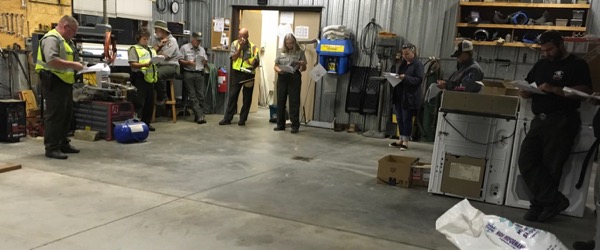
A 5 a.m. debriefing meeting the morning of the eclipse: park rangers, EMT personnel and volunteers ringed the perimeter of the maintenance shop. The friend on whose lawn we camped is the ranger at far left. He was on duty from 10 p.m. the night before all the way to 2 p.m. after the eclipse (after having completed another shift earlier on Sunday).
At the meeting, we learned that overnight, more than 200 people had arrived in the park. While Agate was technically closed, and no camping is allowed, these early birds were allowed to park in the mowed field referred to as Buckley Field, to prevent them from drifting elsewhere and causing a problem for neighboring ranchers.
Bugman and I would be on parking / visitor information duty. Here’s the parking map that was included in our volunteer packets, which was also handed out to park visitors on eclipse day. I had stamped my map with the special eclipse stamp at the visitor center the day before.
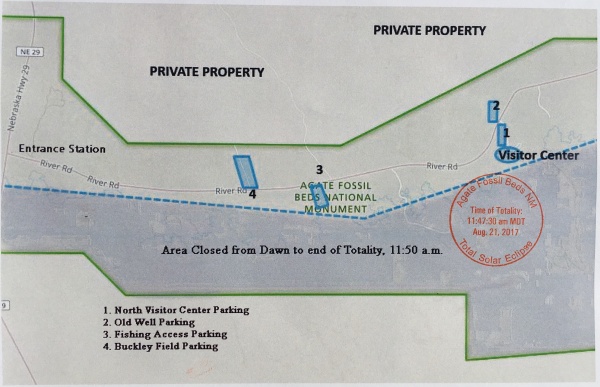
The little white squiggle to the right of the visitor center is the private road where the ranger residences (where we stayed) and maintenance shop are located.
The meeting over, we shuttled our car over to the staff/volunteer parking area next to the visitor center. We could see a line of cars stretching down the road and over the hill, queued for the North Visitor Center Parking area. People took the notice on Agate’s website to heart.

When we met with the ranger in charge of parking, Bugman and I were assigned to work the RV parking lot just north of the visitor center.

Bugman talks parking strategy with a park ranger just before cars are allowed into the lot.
Because he “looked like he could be more aggressive” (*eyeroll*) Bugman was assigned to be the one directing the RVs into their spots, while I got to go stand out in the field to be a human post the vehicles would need to drive around to ensure they swung wide enough to pull straight into the parking spots.
All for the better. We were close to the visitor center and our car with all Bugman’s equipment in it, and we didn’t turn out to be too busy with RV parking (people had heeded the “limited RV parking” warning) so I had plenty of time to lollygag and take photos.

Here they come!

A panorama of the line of cars waiting to get into Agate Fossil Beds National Monument at 6 a.m. on the morning of the eclipse.
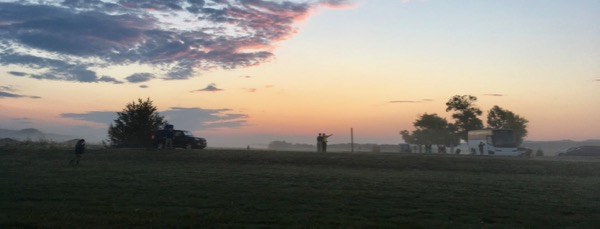
Silhouetted against the dawn, #rangerspointingatthings

One of the stars of today’s show arrives: the sun.
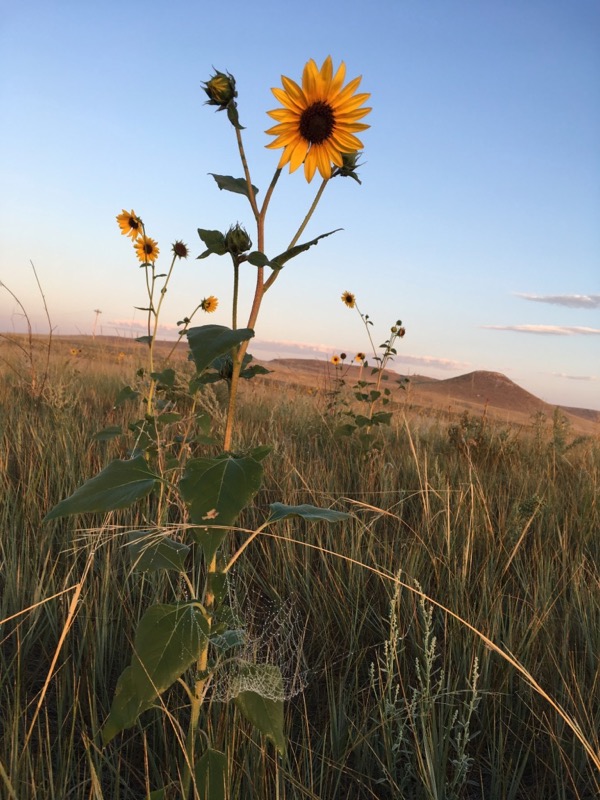
The morning light on the dewy High Plains landscape was magical.

Dewy orb-weaver web

At 6:30 a.m., the foot traffic was constant

My morning shadow on the prairie grasses.

Selfie! Not the most flattering picture of me. My outfit that day was focused on practicality, not fashion.
It didn’t take long for parking lot 1 to fill up. The other parking volunteers moved on to assist at the other parking lots, but Bugman and I stayed put to direct volunteers and people with handicap placards and RVs and buses and EMTs to the right locations. Still, I found time to look around.

A wee cactus starting among the grasses.

Dewy funnel web.
I enjoyed talking with people as they came in. It was really a positive atmosphere. Everyone was excited. One man I spoke with had traveled the world and seen multiple eclipses. A woman from Colorado was wowed by the beauty of the western Nebraska scenery and vowed to come back for another visit. A group in a huge fifth-wheel trailer had driven all night from Lincoln to escape the clouds there. One RV that pulled in (towing a boat!!) had several animals living inside. I could hear the chatter of what sounded like a cockatiel.
I answered visitor questions to the best of my ability. One repeated question was, “where can I get coffee?” There were a couple of food vendors set up in the park, so I assumed there was coffee there, until I wandered over to take a bathroom break, and saw this sad, sad sign:

Who serves sweet rolls without coffee? Dang, somebody missed the chance to make some bucks!
I wound up getting sucked in to restroom maintenance the couple of times I stopped in to use the facilities. There was always a line, and the toilet paper was always running out. It was hot inside the jam-packed visitor center, and the folks working and volunteering inside were running ragged trying to keep up.
The volume of visitors to the park became apparent when rangers made a sweep to count the spots left in the regular visitor center parking lot, which had been reserved for handicap parking. There were 36 spots left. A line of 36 cars from the queue backed up on River Road was allowed in to filter through the pedestrians to park on the paved parking area. (A few people who had arrived earlier and parked in the grass lots further away made sure to inquire about why those 36 cars got special treatment and parking near the visitor center.) Once the paved lot was full, visitors were directed to start parking along the freshly mowed sides of River Road.
Maybe 4,000 people had been expected at Agate for the eclipse. By the time of totality, the greeters stationed at the River Road entrance to the park had tallied over 11,000 visitors! (The typical visitation for a whole year at the park is about 14,000) Holy! Cats!
The nice thing was, people were so spread out around the park, it didn’t feel claustrophobic at all (unless you went into the visitor center or waited in one of the long lines for the limited porta potties).
Around 10 a.m – about an hour and 45 minutes before the eclipse – Bugman and I were relieved from duty so we could haul his recording gear out into the restricted area south of the river. We kept our volunteer “backstage passes” and fluorescent vests on, so other people wouldn’t think we were wayward visitors sneaking somewhere we didn’t belong.
We waded through some tall grasses near the river (no rattlesnakes encountered – whew!) and followed a vehicle track to a devegetated area where some invasive thistles had been killed back.

Setting up the microphone

Setting up some cameras.
Across the river, we could occasionally catch snatches of the Native American program presented by Kelly Looking Horse. Insects vigorously sang in the dense grass around us. Pollinators buzzed around a nearby clump of flowering plants.
I put on my eclipse glasses and could see the beginning indentation of the moon on the upper right side of the moon. I congratulated myself on choosing to wear a straw sun hat. The holes in the weave made great pinhole projectors.

Straw hat eclipse crescents at t-minus 16 minutes.

Bugman used his fingers to project eclipse crescents onto a notebook.

Despite the sun being nearly completely obscured by the moon, the remaining sunlight streaming to Earth was still really intense. Yet, the air felt noticeably colder.
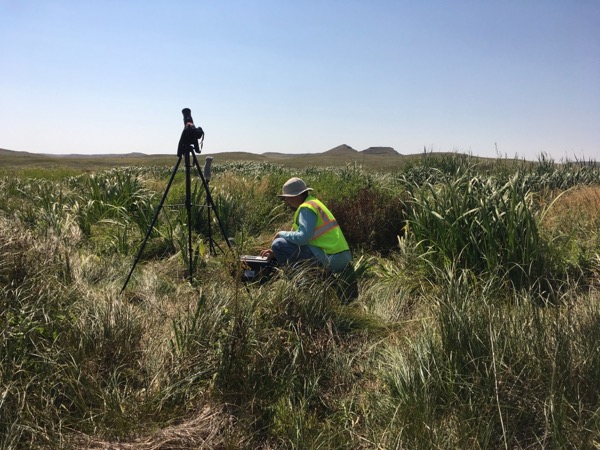
At t-minus 15 minutes, the light was turning brassy.

At t-minus 8 minutes, the quality of the light continued to change. Bugman remarked that it seemed like the yellow light of the “golden hour” and the pink light of a sunset were mixing.
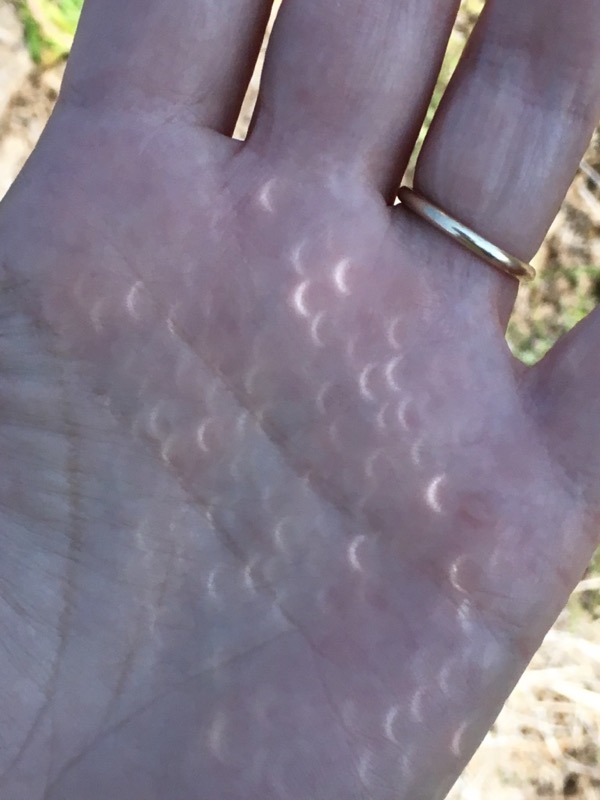
Straw hat eclipse crescents at t-minus 4 minutes.
At t-minus 3 minutes, two private planes droned over the park, leaving an imprint on the audio recording Bugman was attempting. I shook my fist at them for their selfish insensitivity. >:-( The only way I would forgive them and not consider them incorrigible douchecanoes would be if they had been taking pictures of the crowds at the park. (I doubt this was the case.)
Here is my favorite series of images, taken looking to the northeast, towards the park ranger residences, at t-minus 15 minutes, 8 minutes, 30 seconds, and 2 seconds. It really shows how the light changed.

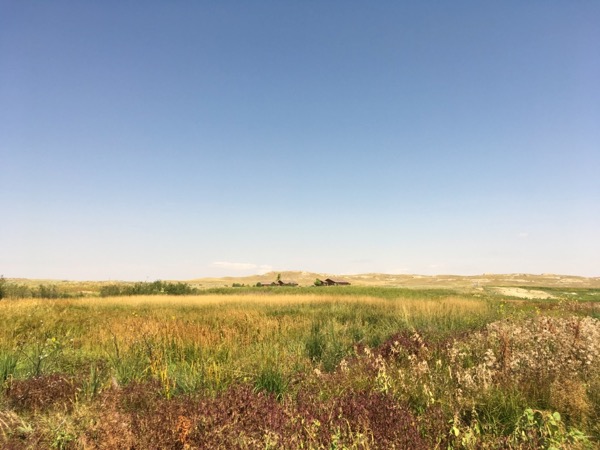


Just after I took that last picture, I heard a roar begin to rise from the crowd across the river. I glanced up and caught sight of the last bit of the sun disappearing on the bottom left side – the “diamond ring” effect.
I don’t think I will ever forget looking up at that fully eclipsed sun. It looked just like the image on the eclipse postage stamps – a black hole surrounded by gentle streamers of white light.

My crummy cell phone camera picture of the total solar eclipse.
Here’s a photo I found later from a weather balloon released by Earth to Sky Calculus. Hey – I’m somewhere in that shadow!
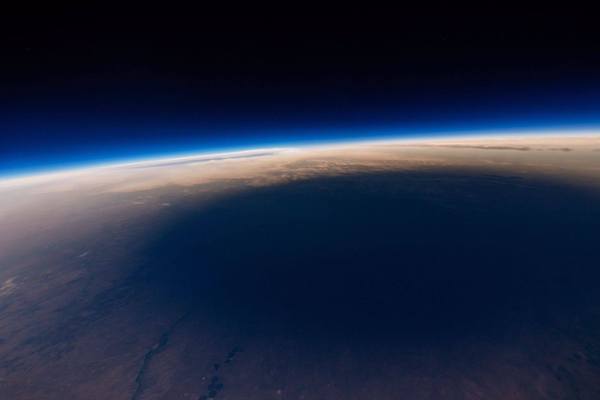
The Moon’s shadow blots out a 70 mile wide patch of terrain in Wyoming/Nebraska during the great American Solar Eclipse. Photo credit: Earth to Sky Calculus/Josh Stansfield The camera, a Panasonic GH4, was riding inside the payload of an Earth to Sky Calculus space weather balloon launched from Ft. Laramie WY. Professional photographer Josh Stansfield helped launch the balloon and he processed these unique images after the payload was recovered from its landing site in Nebraska.
All around us, there was a 360-degree dusk on the horizon. I took a crummy cell phone video of the horizon.
Surprisingly (or perhaps not so surprisingly), Bugman’s equipment did not register any significant change in insect behavior. The critters that were chirping in the grass kept on chirping, and no new ones appeared to join the chorus. There were even pollinators continuing to buzz in the flowering plants.
Too, too soon, as I was taking a panoramic image, the roar came again from the crowd, and the light came back.
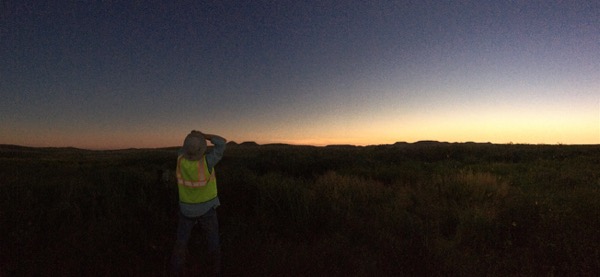
As I was taking this panorama, the sunlight began to return from the west (right).
As I heard and read in many places, and as I can attest, “That was the shortest [fill in the length of totality] of my life!”
So much hype and build-up for such a tiny fraction of time. I suppose I should have celebrated the return of the sun, but I felt bereft. I needed more time to gaze at celestial wonder.
Across the river, cars were already beginning to make their way out of the parking lot.

At t-plus 17, the straw hat eclipse crescents had flipped orientation from the t-minus images.
Bugman packed up his equipment and we hiked back to our car, passing a woman seated on the path who appeared to be praying over some crystals. The volunteer astronomers were all still set up, observing the waning eclipse.
The stream of traffic out of the park was constant by now, vehicles squeezing past pedestrians on the narrow road. It dawned on me that the post-eclipse travel might actually be more hazardous than arrival traffic, as more people were headed out en masse.
We headed back to our friend’s place, ate some lunch, and packed up our stuff. We waited until about 2 p.m. to join the flow of outbound traffic. The ranger who’d worked with us in the parking lot that morning was still managing traffic flow.
Southbound on Highway 29, there were vehicles as far as the eye could see – NOT a normal circumstance for Sioux County, Nebraska!

There was ample evidence in trampled grass, tire ruts, and torn-up slopes of many, many vehicles and people having left the pavement. Some of them were still parked there, the people kicked back in their lawn chairs, watching the traffic parade.

At Mitchell, the traffic on Highway 26 was pretty heavy, too, relatively speaking.

We made it back home to Scottsbluff within a normal transit time from Agate, though.
Wow. What an experience!
Now that I know what totality feels like, I wonder . . . will I find myself in the path of totality in 2024?
Copyright 2017 by Katie Bradshaw, except photos as noted

Wonderful description of this nearly once in a lifetime event. We were so impressed with the “star folk” who came to our world.
As always, I enjoy your take on the world. Thanks for sharing the experience!